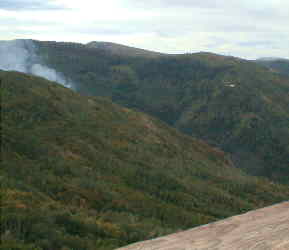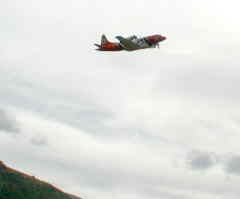
Click on the picture for a larger version
The great Thad's Peak fire of 2002
Dateline: August 30, 2002:
 |
Well, Ok... There's nothing "great" about a fire that is threatening to burn your house or cabin down, but if you escape unscathed, then it is always something to talk about in the future. Also, because it was dangerous, there really aren't many pictures of the fire itself - just those of the airplanes that were sent to help contain it and plumes of smoke rising from behind the ridge and some of the "mopping up" efforts after it had been contained.
Note: To get a larger version of a picture, simply "click" on it!
This fire, believed to have been lightning-caused, is shown burning below Thad's Peak, east of Fairview Utah. This area is dotted with cabins and trailers and is a popular spot for recreation and relaxation. Because of the rugged terrain vehicle access is somewhat limited and the relative lack of water, various tasks (like fighting a fire, for instance) can be complicated a bit.
The fire appeared to start in the evening of August 28 or early morning of August 29 and fire-control efforts began quickly. The area, like much of the rest of the state of Utah, is suffering from drought (a fact that further limits the availability of water and enhances the potential of the fire's area to expand) and quick control of this fire - like any fire - is essential to limit its spread.
The first picture shows a "fire bomber" on its
"bombing
run." Typically, a fire retardant is dropped either on the fire
itself,
or on the leading edge of it in order to slow its spread.
The second picture was taken just after the plane had dropped its load of fire retardant. Just to the right of the line of smoke rising from behind the ridge you can easily see the red plume of fire retardant. Immediately above and just to the right of the red plume you can just barely make out the plane, heading directly toward the camera, if you click on the picture and look at the large version.
Typically, when aircraft are used to fight fires, there isn't' just one plane in the air: There is nearly always a small spotter plane. It is from this plane that observations are made that allow the other aircraft to best fight the fire - that is, tell the bombers where to drop their loads. This is important for several reasons: The fire may shift with the wind and weather, requiring that extra attention to be placed on a certain location. Also, as the load of fire retardant are dropped, if they have the desired effect (or if they don't) the dynamics of the situation also change where future loads are to be dropped. Finally, because the bomber flies quite low, its pilot must know beforehand exactly where to drop the load - because a slow, heavily-laden plane cannot possibly make a quick course correction.
In addition to these duties, the spotter plane can
also
relay to ground fire-fighting crews and coordinators what exactly is
going
on as well as facilitate communications between various parties in case
the terrain makes radio communications difficult.
 |
The third (and final) picture gives a better view of the plane. Typically, the fire-fighting planes are older propeller-driven aircraft, having been retired from passenger and cargo service. This picture was taken after the plane had dropped its load of fire retardant: It flew toward the camera and turned west again to head back toward the valley - completing what turned out to be the final "bombing run."
It is well worth mentioning at this point that that very day (August 30) the fire was controlled and effectively quashed.
Having a fire nearby makes one wonder if he/she has done enough to protect their property and is great impetus to getting one to take the usual steps such as clearing a "firebreak" around the building - that is, a perimeter that is pretty much free of vegetation that could, in the event of a fire, threaten the structure.
It was somewhat disconcerting to learn that an evacuation notice was issued where all trailers were to be moved out of the area - something that makes one think of getting all of those things that you really might want to save together - just in case the unthinkable happens.
The following pictures were taken during the Thad's Peak fire by Fred Johnson.
Click on any of the images to get a larger version.
Last page update: 20030314
For comments and feedback on this page, you may contact Glen via
Email.
Since June, 2011, this page has had this many visitors: